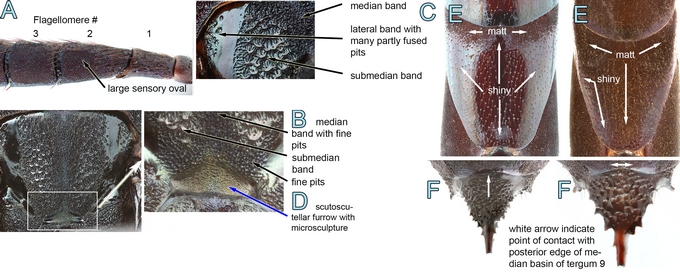
1. Female flagellomere 2 in dorsal view with a sensory oval covering
about 0.5 of flagellomere surface (A); mesoscutum with median
longitudinal band (outlined by finer pits) with pits extending
laterally posterior to submedian band (B); mesoscutum with many
(>10) often fused pits on anterolateral corner of lateral band (C);
mesoscutum with convex sculpticells on all or at least 0.7 of median
surface of scutoscutellar furrow; surface with microsculpture with a
clear metallic yellow green hue (D); female, tergum 8 shiny (with no
pitted sculpticells) at least along lateral margin in posterior 0.5
(E); female tergum 10 in dorsal view with pits extended medially to
and not reaching posterior edge of median basin of tergum 9 or
extended on 0.3 of edge medially (F) ... 2
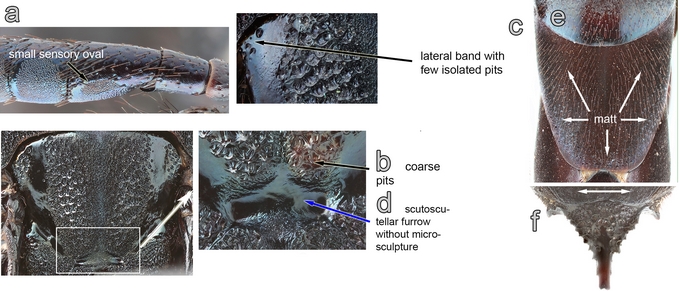
–
Female flagellomere 2 in inner view with a sensory oval covering
less than 0.2 of flagellomere surface (a); mesoscutum with median
longitudinal band (outlined by finer pits) with pits not extending
posterior to submedian band (b); mesoscutum with few pits (<10)
usually isolated on anterolateral corner of lateral band (c);
mesoscutum without convex sculpticells at most with flat
sculpticells on about 0.25 of median surface of scutoscutellar
furrow; surface with microsculpture without a clear metallic hue
(d); female tergum 8 completely matt (microsculpture deeply
impressed, sculpticells pit-like) (e); female tergum 10 in dorsal
view with pits extended on about 0.7 of posterior edge of median
basin of tergum 9 medially (f) ... 5
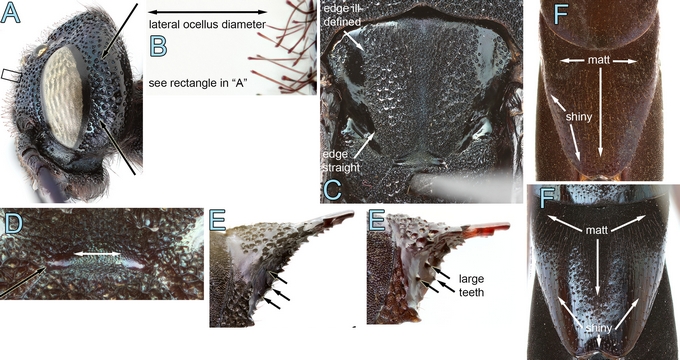
2.
Gena with pits very dense (usually polygonal in outline) and large
(0.2–0.4X as large as diameter of lateral ocellus) in ventral 0.7,
and scattered and small pits (0.2–0.3X as large as diameter of
lateral ocellus) in dorsal 0.3 (A); clypeus, frons and postocellar
area with apex of setae clearly clubbed (club about twice as wide as
setal shaft); and on frons setae 0.5–0.7X as long as diameter of
lateral ocellus (B); mesoscutum with submedian band not sharply
outlined laterally; in posterior 0.5 straight (C); mesoscutum with
convex sculpticells on about 0.7 of median surface of scutoscutellar
furrow (D); female tergum 10 in lateral view with teeth posterior to
lateral tooth (E); female tergum 8 with deep pit-like sculpticells
in basal 0.4–0.5 and medially reaching or not posterior edge,
remaining surface shiny (without pitted sculpticells) (F) ... 4
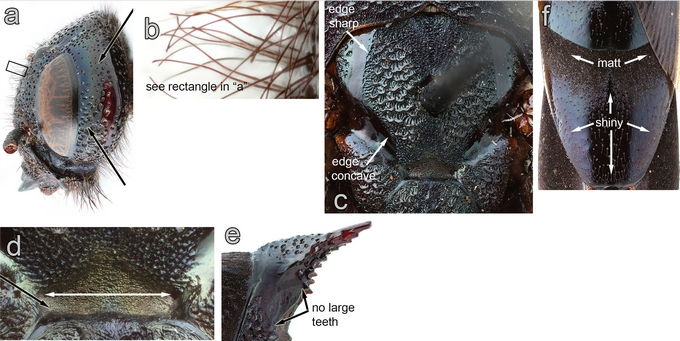
–
Gena with less dense pits (usually circular in outline) and quite
large (0.2–0.3X as large as diameter of lateral ocellus) near
mandible in ventral 0.2, and scattered and fine pits (at most 0.15X
as large as lateral ocellus) on dorsal 0.5 (a); clypeus, frons and
postocellar area with apex of setae slightly clubbed or truncate
(club about 1.5X as wide as setal shaft); and on frons setae
1.5–2.0X as long as diameter of lateral ocellus (b); mesoscutum with
submedian band sharply outlined laterally; in posterior 0.5 clearly
curved inward (c); mesoscutum with convex sculpticells on all or
almost all of median surface of scutoscutellar furrow (d); female
tergum 10 in lateral view without teeth posterior to lateral tooth
(e); female tergum 8 with pit-like sculpticells on basal 0.2–0.4
(surface matt), and shiny on apical 0.6–0.8 with a medial shiny
triangle extended near base (partly dividing the transverse band
with pitted sculpticells) (f)
... 3
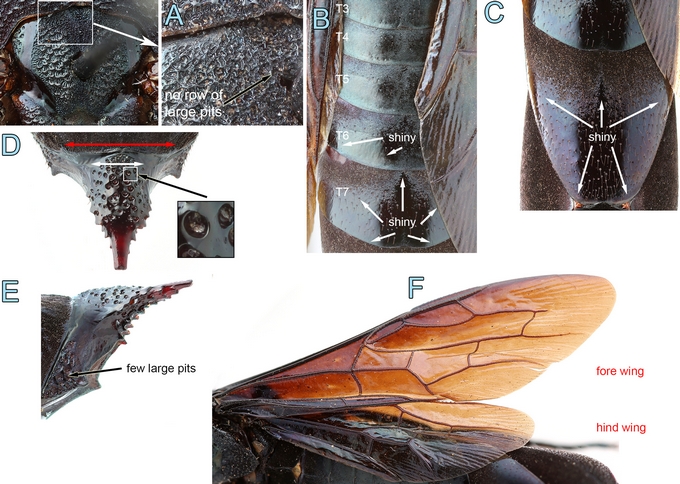
3.
Mesoscutum on anterior 0.3 of median band without longitudinal row
of large pits (A); female terga 4 and 5 with matt surface; tergum 6
shiny posteromedially on 0.25 of surface; tergum 7 shiny
posteromedially on 0.7 of surface (B); female tergum 8 shiny
posteriorly on 0.6–0.7 of surface (C); female tergum 10 in dorsal
view with pits spread about 0.5 times as wide as posterior edge of
median basin of tergum 9 (D); surface between pits smooth (E,
insert); female tergum 10 in lateral view anterior lateral tooth
surface with few large pits (F); female fore and hind wings darkly
tinted (G)
...
Afrotremex violaceus
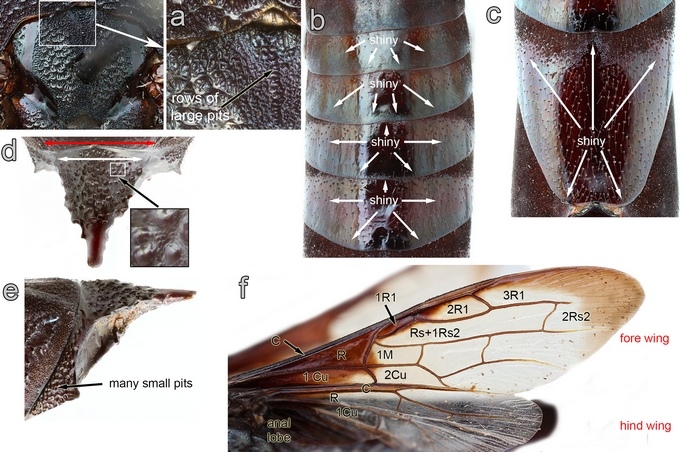
–
Mesoscutum on anterior 0.3 of median band with a longitudinal row of
large pits (about 0.25X as large as diameter of lateral ocellus)
(a); female tergum 4 shiny anteromedially on 0.25 of surface; tergum
5 shiny anteromedially on 0.5 of surface; tergum 6 shiny
anteromedially on 0.8 of surface; tergum 7 shiny anteromedially on
0.9 of surface (b); female tergum 8 shiny posteriorly on about 0.85
of surface (c); female tergum 10 in dorsal view with pits spread
about 0.75X as wide as of posterior edge of median basin of tergum 9
(d); surface between pits with meshes of microsculpture except
centrally (e, insert); female tergum 10 in lateral view anterior
lateral tooth surface with many small pits (f); female fore wing
clear in central area; darkly tinted in the following cells: C, R,
1Cu (except for small clear spot posteroapically), 1A (except for
clear spot in apical 0.5 – not visible in figure), 1M (small
anterobasal spot), 2Cu (small anterobasal spot), 1R1, 2R1 (small
basal spot), 3R1 (anterior 0.5 lightly tinted); Rs+1Rs2 (only near
1R1); 2Rs2 (lightly tinted in apical 0.5 (g); hind wing mainly
clear; darkly tinted in the following cells: C (not visible in
figure), R (dark spot in basal 0.4), 1Cu (dark spot in basal 0.4),
most of anal lobe (except for clear central spot) (h)
...
Afrotremex pallipennis
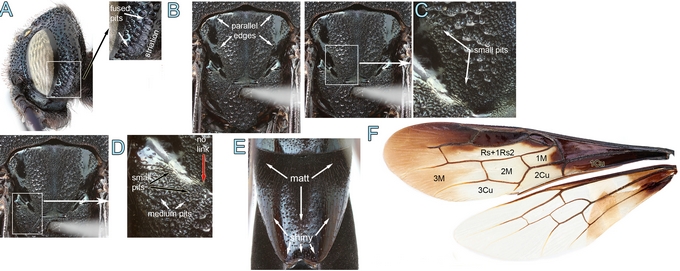
4.
Gena with a row of pits with raised posterior edge extended from
lower eye margin to occiput at about the eye middle height; pits
fused and bottom striated (A, insert); mesoscutum with lateral edge
of submedian band parallel in anterior 0.5 (B); mesoscutum with a
band of small pits (similar to those of median band) along lateral
margin of submedian band in posterior 0.5 (C); axilla with medium
size pits centrally (D, white arrows); with small pits (similar in
size to those of median band) along anterior edge (E, black arrows);
and pitted surface of submedian band not connected to anteromedian
corner of axilla (at most some transverse wrinkles) (F, red arrow);
female tergum 8 broadly shiny in posterior 0.6 except for median
matt extension not reaching posterior edge (G); female fore wing
with more extensive clear membrane in following cells: apical spot
of 1Cu, apical 0.7 of 1M, almost all of 2Cu, most of Rs+1Rs2, basal
0.3 of 3M, basal 0.7 of 3Cu, 2M, 2A (not visible in figure), and
apical 0.25 of 1A (not visible in figure); hind wing clear in apical
0.5 (H) ...
Afrotremex hyalinatus
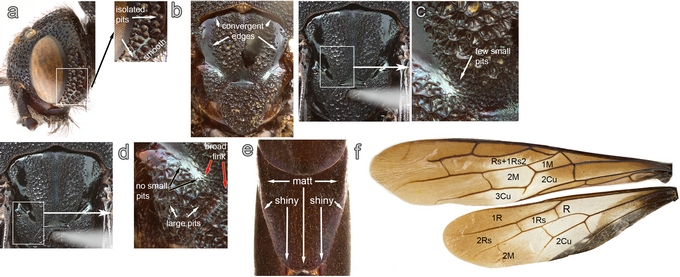
–
Gena with a row of pits with raised posterior edge extended from
lower eye margin to occiput at about the eye middle height; each pit
round, not fused, and bottom smooth (a, insert); mesoscutum with
lateral edge of submedian band convergent in anterior 0.5 (b);
mesoscutum with some small pits (similar to those of median band)
along lateral margin of submedian band in posterior 0.5 (c); axilla
with many large pits (d, white arrows); without small pits (similar
in size to those of median band) along anterior edge (e, black
arrows); and pits surface of submedian band on posterior margin
connected to anterior median 0.3 edge of axilla (f, red arrows);
female tergum 8 broadly shiny in posterior 0.5 along lateral margin,
matt extension broad medially and reaching posterior edge (h);
female fore wing with less extensive clear membrane in following
cells: apical 0.5 of 1M, apical 0.5 of 2Cu, central area of Rs+1Rs2
near vein M, basal 0.5 of 3Cu, basal 0.75 of 2M; hind wing in apical
0.5 darkly tinted in following cells: R1, 2Rs, apical 0.5 of 2M,
except for centre of 1Rs, apical corner of 2Cu, and apical margin of
R (i) ...
Afrotremex xylophagus
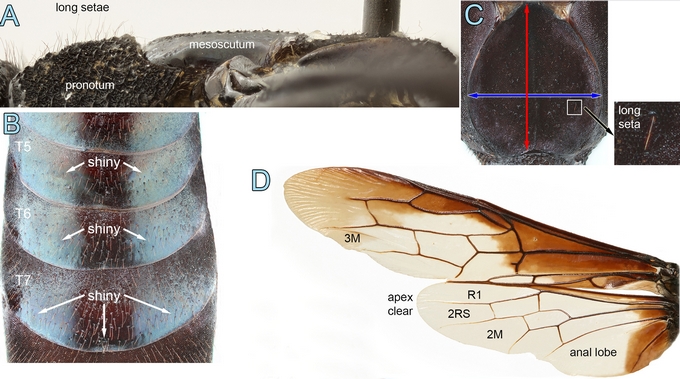
5.
Pronotum medially with numerous long setae medially (best seen in
lateral view) (A); female tergum 4 shiny in central 0.25; tergum 5
shiny in central 0.5; tergum 6 shiny in central 0.7; tergum 7 shiny
in posterior 0.5 (B); female tergum 9 with median basin slightly
longer (maximum width/ maximum length: 0.85–0.97) (C); setae about
twice as long as tubercle (D, insert); female fore wing not as
darkly tinted in following cell: apical 0.3 of 3M; hind wing clear
at apex and darkly tinted on basal 0.5 of anal lobe (E) ...
Afrotremex comatus
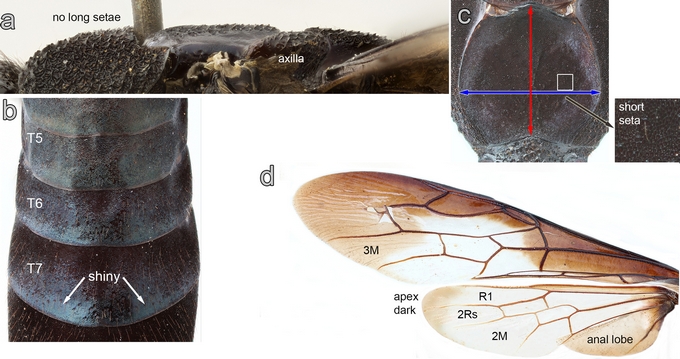
–
Pronotum medially without or with very few and very small setae
(best seen in lateral view) (a); female tergum 4–6 not shiny; tergum
7 shiny on a small submedian area (b); female, tergum 9 with median
basin slightly wider (maximum width/ maximum median length:
1.05–1.07) (c); setae about as long as tubercle (d, insert); female
fore wing not as darkly tinted in following cell: most 3M, and
posterior margin of 3CU; hind wing darkly tinted on most of anal
lobe except for small more or less clear spot anteriorly and at apex
in apical 0.3 of R1, 0.25 of 2RS, and posterior margin of 2M near
its apex (e) ...
Afrotremex opacus
|